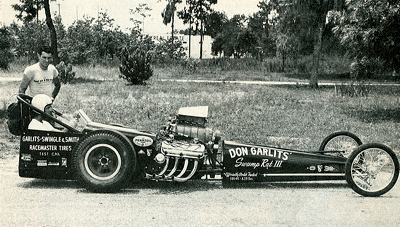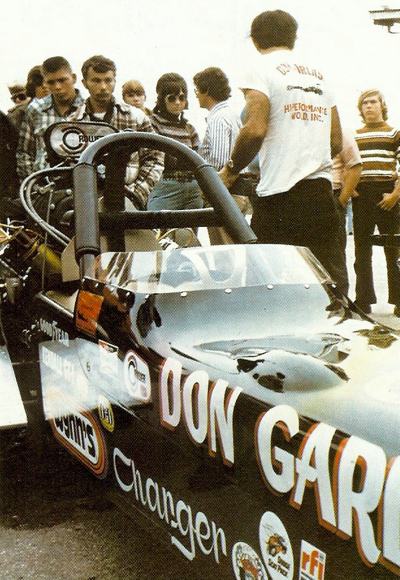Did Don Garlits Drive a Funny Car
| Don Garlits (b. 1932) - aka "Big Daddy" | | |
| | ||
In his day, it could truthfully be said that Don Garlits released more horsepower onto tarmac than any other motor sportsman in history, yet he remained little known outside America. The sport in which he achieved equal measures of fame and fortune in the USA was drag racing, the supercharged standing-start sprint down a flat quarter-mile strip.
Garlits was born in Tampa, Florida, on 14 January 1932. His father was an engineer who had gone to Florida, like so many others, to try and get rich by fruit farming. 1932 saw his orange-growing business collapse under a combined attack from fruit flies and his bank, so young Don did not quite get a de-luxe introduction to life. The family scratched by though, and Don eased through his early years, acquiring a reasonable education and a loose interest in hot rods by the time he was seventeen.
The trouble was that he and his friends rarely saw one: it was strictly a West Coast fad. A few years after Garlits had left school and passed through a few abortive jobs, hot rods really started to catch the kids' interest in Florida. Garlits and his friends all had them, and their main source of fun was rushing around Tampa at all hours of day and night, racing each other at traffic lights and drive-ins. Soon, they found their own place to race off the street, and the Tampa kids set up a drag strip just like the ones they had read about in magazines from California.
Top Eliminator, Zephyr Hills Raceway
Garlits stayed in and around the hot rod/drag-racing scene, driving faster and faster and learning more and more about what made cars flash down that 440 yard strip just those few fractions of a second faster. In 1955, he won his first major title - Top Eliminator, Zephyr Hills Raceway - and suddenly Don Garlits was in drag racing in a big way. Building and racing drag cars became his career, and the next couple of years were spent taking more titles, although he never strayed far out of Florida in those early professional days.
In 1957, he took his car to a National meeting in Illinois and served notice that in future he was going to be the man to beat, by almost taking the Top Eliminator title once again, this time, against very stiff opposition. He still was not making much money out of the sport though, and had to relay on his mechanical skill and innovative powers to keep him up with the front runners. Cars were, by now; running at well over 150 miles per hour and recording sub-nine-second times for the quarter. All kinds of new tricks were being tried to shave off those vital few milliseconds.
At about this time, some of the drivers were switching to dragsters with engines in the rear, but Garlits did not think much of the idea then. Several years later he changed his mind completely. In 1959, Garlits had his first serious accident, at a race in Chester, South Carolina. A bad fire, caused by a ruptured manifold at over 170 mph, put him in hospital for several weeks with serious burns, and changed the whole attitude of the drag-racing world towards protective clothing. It did not deter him though, and he started running a team of cars. People like Art Malone and Connie Swingle drove his cars with repeated success and his reputation as a builder increased, despite reluctance by the Californian faction to accept him as a top ranker.

Don Garlits Swamp Rat III.

Don Garlits Wynn's Charger.
Don Garlits' Swamp Rat
In 1960 Garlits retired briefly after spinning his car at 165 mph and dealing his confidence a serious blow. It was a short-lived lay-off though, and he was back in the hot seat before too many months had passed. Soon, he was running as strong as ever, but 1960 and 1961 were not particularly good years for him, dogged as they were with ill-luck and a long string of breakages. Another fire in 1961 put him back in hospital for a short time, and for most of that year he concentrated mainly on building replicas of his car, dubbed 'Swamp Rat', for customers.
1963 saw him back with a vengeance though, and a big bundle of sponsorship money as well. It was a good year in terms of racing successes, especially when he became the first man to break the 200 mph barrier on the drag strip. 1964 was equally good, with Garlits taking the National title and even managing a trip to England, along with several other top American drag-racing stars. They delighted the English fans, and laid the groundwork for development in the UK.
The following year was a bad one. Many defeats and a bad accident at a strip in Maryland kept him out of the headlines and there was talk of him being past it. After all, he had already been a front runner for ten years. The critics could not have been more wrong though. The remaining years of the sixties passed, and Garlits was always on or near the top. The early seventies saw him in another serious accident, this time losing part of one foot when a differential on his car exploded. This time it seemed as if he really was finished, but before too long he was back on the strip once more, with the resolve that he would never drive a front-engined car again.
It was not long before he clawed his way back to the top and, in 1974, he staggered everyone at the Super-nationals in California by going straight out to record a time of 5.80 seconds! 1975 saw Big Daddy take no less than three NHRA titles. But the following year he was to achieve the fastest time of all, a sensational 5.63 secs 250.6 mph (NHRA). Garlits won three National Hot Rod Association world championships, the last at age 54. He won a total of 144 national events.
Swamp Rat XXX
On October 20, 1987, his Top Fuel dragster, Swamp Rat XXX, the sport's only successful streamlined car, was enshrined in National Museum of American History, a branch of The Smithsonian museum in Washington, DC. In true Garlits style, during the press conference submission and placement ceremony, the dragster was fired on the Smithsonian "porch." In 1987, Garlits suffered what drag racers call a blowover at a drag racing event in in the state of Washington at an AHRA event. He received several injuries from the resulting crash. Though none were life threatening, he temporarily retired from active driving and became a commentator for NHRA telecasts on TNN and for NBC. He announced for four seasons, from 1988 through the end of 1991.
In December 1991 Garlits came out of retirement to race in the Snowbird Nationals, but his comeback was to be short lived. "Big Daddy" retired again before the end of the 1992 season due to a separated retina, a product of the 4g deceleration produced by a Top Fuel Dragster's braking parachutes. Garlits resumed his career briefly in 1998, and again in 2003. His last qualifying race was in May 2003 at the NHRA POWERade Drag Racing Series, 23rd annual Summit Racing Equipment NHRA Southern Nationals presented by Pontiac in Atlanta, Georgia. At the age of 71 years, 5 months and 19 days he qualified 16th setting a personal best speed in the quarter mile with a time of 4.788 seconds at 319.98 miles per hour.
Garlits had reached 323.04 earlier in the year at the 2003 Gatornationals. Mr. Garlits lost in first round competition with his Summit Racing-Mono Winged Dragster with a 0.064 reaction time, a personal best 4.737 elapsed time, at 307.44 miles per hour to Brandon Bernstein's (son of racing legend Kenny Berstein,) Budweiser/Lucas Oil Dragster 0.079 reaction time, a 4.615 elapsed time, at 321.42 miles per hour. The difference at the finish line was 107 thousandths of a second. Garlits operates the Don Garlits Museum of Drag Racing on the grounds of his home in Ocala, Florida. He can also be seen from time to time on ESPN and Speed Vision doing commentary at racing events and performance expositions.
Always at the forefront of driver safety, in the wake of Funny Car driver Scott Kalitta's fatal crash, Garlits declared "I am 100-percent in favor of it", regarding NHRA's proposal to trim the race distance for Top Fuel and Funny Car from the traditional quarter-mile to 1,000 feet, also suggesting that he would support a ban on rev limiters and a return to a 70/30 nitromethane to methanol ratio. He has later had second thoughts. In September 2009, Garlits returned to the quarter mile, racing a specially prepared 2009 Dodge Challenger in the stock eliminator class at the U.S. Nationals in Indianapolis, IN.
Source: https://www.uniquecarsandparts.com/race_drivers_don_garlits.htm
0 Response to "Did Don Garlits Drive a Funny Car"
Post a Comment